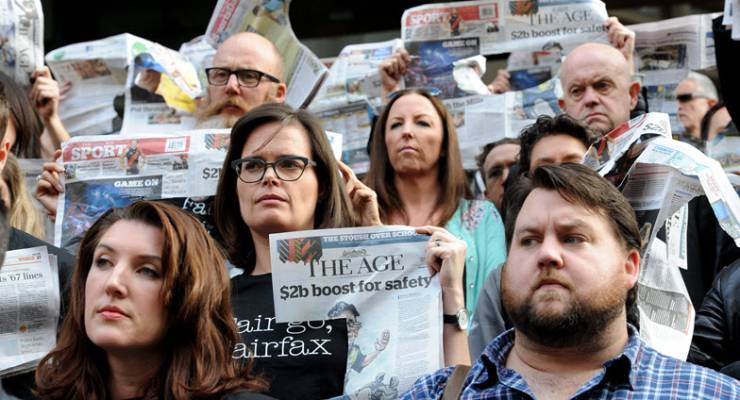
The striking Fairfax journalists deserve credit for puncturing the idea that reshaping news media can only occur – or can occur at all — within the sort of narrow Micawber-ism being pushed out by Fairfax management.
In the editorials attacking their own striking staff this week, the Australian Financial Review demonstrated a misunderstanding of the ramifications of its own corporate strategy. They indicated that while the company is talking up the future, when it comes to how to get there, they are locked somewhere in the past.
A couple of weeks ago, Crikey blew time on the advertising model for mass media news. The commentary around the Fairfax strike has quickly made this a commonplace. (Disclosure: I’m the former federal secretary of the journalists’ union MEAA).
Without advertising, the key strategy for all mass media companies — particularly those rooted in print like Fairfax or News — is to achieve most of their revenues directly from readers. That’s the apparent justification behind the latest Fairfax cuts. They’re about re-setting costs at a level that can be sustained by subscriptions.
But growing reader revenues to levels that sustain mass media requires an investment in journalism. That was the boast that News Corp made in The Australian, attributing its digital growth to “continuing investment in premium content”.
The cultural and structural changes demanded by a shift from advertising to reader revenues are so profound that you can’t do it while delivering quarter by quarter profits. That’s the approach of Charles Dicken’s Mr Micawber in David Copperfield: “Annual income twenty pounds, annual expenditure nineteen pounds nineteen and six, result happiness. Annual income twenty pounds, annual expenditure twenty pounds nought and six, result misery.”
A look at Fairfax Media’s metro publishing revenues for FY 2016 (that is, print plus digital) shows us Mr Micawber in action. Revenues were $575 million (about 90% of them from print). As these revenues slide, the company has worked to keep the cost curve trending down underneath it to continue to meet the pressure for quarter by quarter EBITDA (Earnings before interest, tax, depreciation and amortisation) that will hold up the share price. The figures in the end of 2016 statement showed this starkly: revenues declined by 8% while costs “improved” (meaning they also came down) by 9%. Mr Micawber would be delighted!
This demands more “improvement” in costs this year (that is, the $30 million in cuts announced by the company). It’s likely to mean more cost cuts next year.
Share market happiness may depend on hitting quarter by quarter EBITDA but it’s hard to see how reader revenues can sustain mass journalism at their current level. According to the company statement on the end of 2016 figures, Fairfax had a digital subscriber base of 226,000 across the AFR, the SMH and The Age, with a half year income of $22 million. Let’s get out our calculator … annualise that … apply The New York Times‘ achievement of having two parts reader revenues to one part advertising or other revenues, factor in some marginal growth … calculator whirrs …
Hmm. That gives a potential digital product assumed revenues of about $70 million, maybe creeping up to $80 or $90 million. Now that would constrain executive salaries! But would it be enough to build a mass media model?
News Corp, of course, is in a similar position. Its end of March report claimed 333,400 in total digital subscriptions for its Australian mastheads, boosted by the recently added regional papers in Queensland. It also reported that 24% of its news and information revenues in the first quarter were digital revenues, although it is not clear how much of this came from advertising, content marketing or subscriptions. These segments revenues are also dominated by The Wall Street Journal, which boasts about 1.2 million digital subscribers at the end of the quarter.
The other unknown about digital subscription revenues for all companies is just how much is purely digital and how much derives from a joint print-digital subscription.
However, as a global corporation with a dominant shareholder, News Corp is not under the same pressure to feed the market with cost cutting tidbits, although we know they are cutting $40 million this year, much of it in journalists’ jobs.
Unfortunately for growth, the cost cutting call-out to the share market is heard, too, by readers. But while the market hears, “Profits!”, readers hear, “Fewer journalists, less news!” It’s a mixed message that undermines growth.
A start-up approach would break free of the tyranny of quarterly earnings, accepting the imperative of investment in real content to break the constraints on digital growth. And maybe like a lot of start-ups, the Fairfax papers would be better off outside the regimen of publicly listed ownership to give it the space to build without the market demands of the next quarter figures.







No. The numbers will never hold up. The last ever generation to accept the concept of monetised information (on a sustainable mass media scale) was born a decade ago.
Good article.
…or perhaps two decades ago.
Quite a simple equation really: fewer journalists=less news=angry readers.
But, hey, if it gets you a Maserati as your erstwhile minions trudge out of the door, what’s the problem?